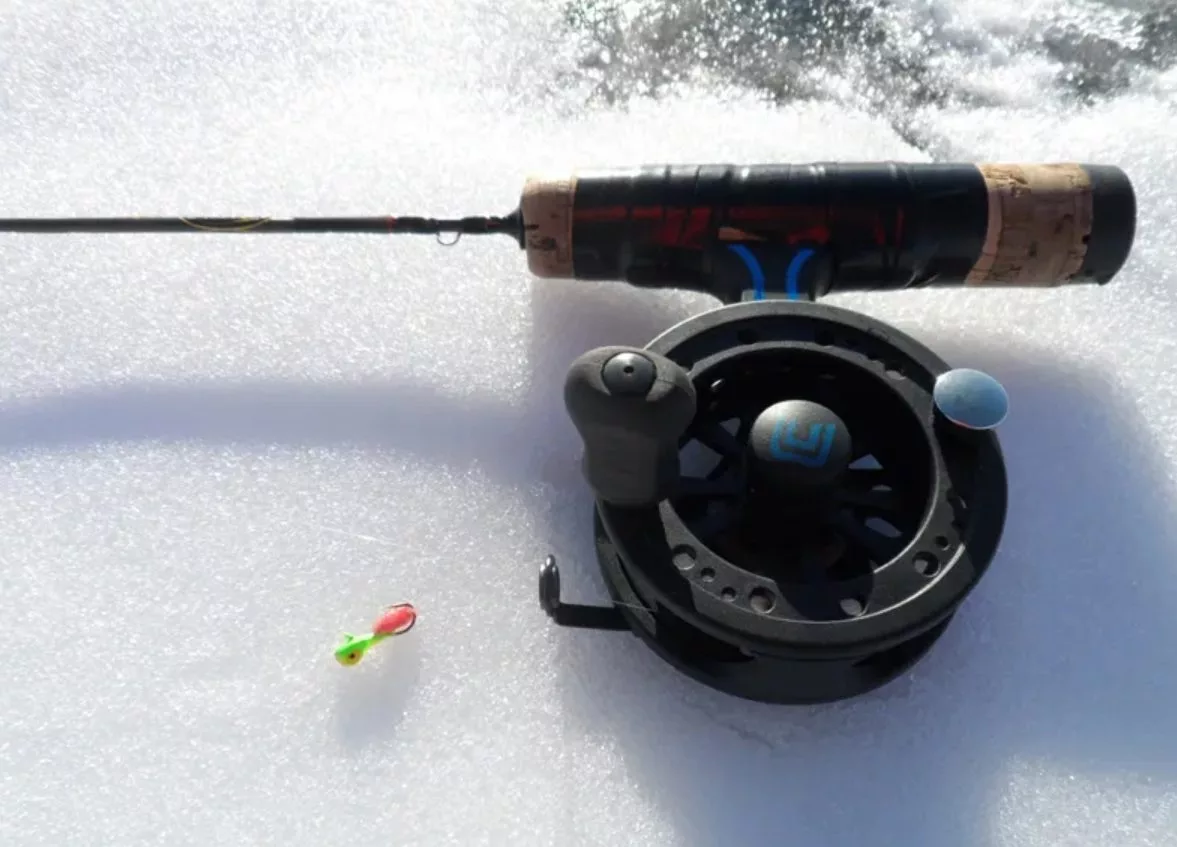
All Around Good. Using round, fly-style reels for finesse ice fishing presentations will help ensure that line twist is kept to a minimum, spinning lures aren’t as frequent, and hopefully, bites are more plentiful when fish come in for a look. Simonson Photo.
By Nick Simonson
The physics of line twist can impact the quality of a presentation under the ice, at a time when everything needs to come together to convert fish in midwinter, the toughest of angling seasons. Knowing what causes line twist and the resulting spin of a lure, and the solutions to the problem, can help keep things looking just right to trigger a better hardwater bite.
Talking Twist
In recent years, most ice fishing has been done with an open-faced spinning reel. Anglers wind line out of a box up the small blank of the ice rod and onto the reel, just like they would in summer. Taking an already-wound line off a wide spool, unwinding it, and rewinding it in tighter loops around a smaller spool is the starting point of most issues involving lure spin. The tighter loops create tension different from how the line was stored on the shelf. That tension creates line twist and that twist’s potential energy is stored up on the reel. The longer the line is on the reel, the more the line conforms to the spool, holding the twist in place.
Additionally, the line is stored horizontally on a spinning reel, compared to the vertical presentation which occurs when the lure is dropped down the ice hole, which the weight of the jig or spoon tries to correct once off the reel. By placing the lure just below the water’s surface in the ice hole, an angler can watch this conversion of potential energy (the twists in the line on the spool) to kinetic energy (the spin of the lure, trying to work out the twists).
This spinning motion causes unwanted movement of jigs and spoons, making it tough to get a perfectly still presentation under the ice. Fish – especially panfish – are reluctant to take an unnaturally moving morsel, and few nymphs, minnows or other food species have ever been observed spinning wildly by their nose in a natural setting. I’ve even watched walleyes stare down a spinning spoon before striking only when it stops. Oftentimes a bite will come only after the lure has stopped spinning, which may take quite a while. This delay can send fish swimming the other way.
Solving the Spin
There are many ways – new and old – to help anglers eliminate spin when pursuing panfish, or even predator fish like walleyes and trout. From employing new reel models, to using specific combos to making spin elimination part of your seasonal preparations, there are options to get rid of unwanted rotation in all your on-ice adventures.
In the past few years, fly style reels have been highly touted by ice anglers targeting bluegills, perch and crappies. These round reels, now offered by many noted ice fishing companies, hold the line vertically, so it is released smoothly off the wide arbor spool, which is, in most cases, approximately the same size as a spool of ice fishing line, straight off the tackle shop shelf. The storage of the line in a vertical position, and in a similar spool size, eliminates a great deal of line twist. Ice-specific drag mechanisms and free spool buttons allow anglers to get lures down to the fish just as fast as with a standard spinning reel.
Serious anglers have a rod for every species and with the expansion of many affordable models for all pursuits on the ice, they are right to do so. Having a dedicated rod for walleyes, one for panfish, and one for pike – each spooled with different lines and used for lures of various sizes – helps to eliminate lure spin when a finesse presentation is required.
Try jigging and ripping a spoon under the ice for pike or walleyes and you’ll see spin in its harshest form. The wild wobbles and darting motions of the lure build energy back into the line, so that when the spoon is held still, it spins on its axis. Now, imagine using that same rod for panfish, trying to present tiny jigs with all that twist in the line. The tiny 1/64-ounce jig would spend most of the day rotating back and forth trying to work the spoon’s stored up energy out of the line and would rarely stay still. Dedicating a rod to each type of fishing – spoons, finesse, deadsticking, etc. – helps eliminate lure spin.
Finally, replacing line each season, or more frequently depending on the time spent on ice each winter, helps eliminate spin. The longer that line spends on the spool, the more memory it takes on, as it tries to hold the shape of the spool. Last year’s line, if not removed, will have a greater tendency to spin during this ice season than if a fresh spool of line is placed on the reel.
New reels, species-specific rods, and a little investment in new line each season will help put the brakes on unwanted rotation. Try these options to solve the age-old problem of lure spin for a perfect presentation and a better ice fishing experience now and throughout the hardwater season.
